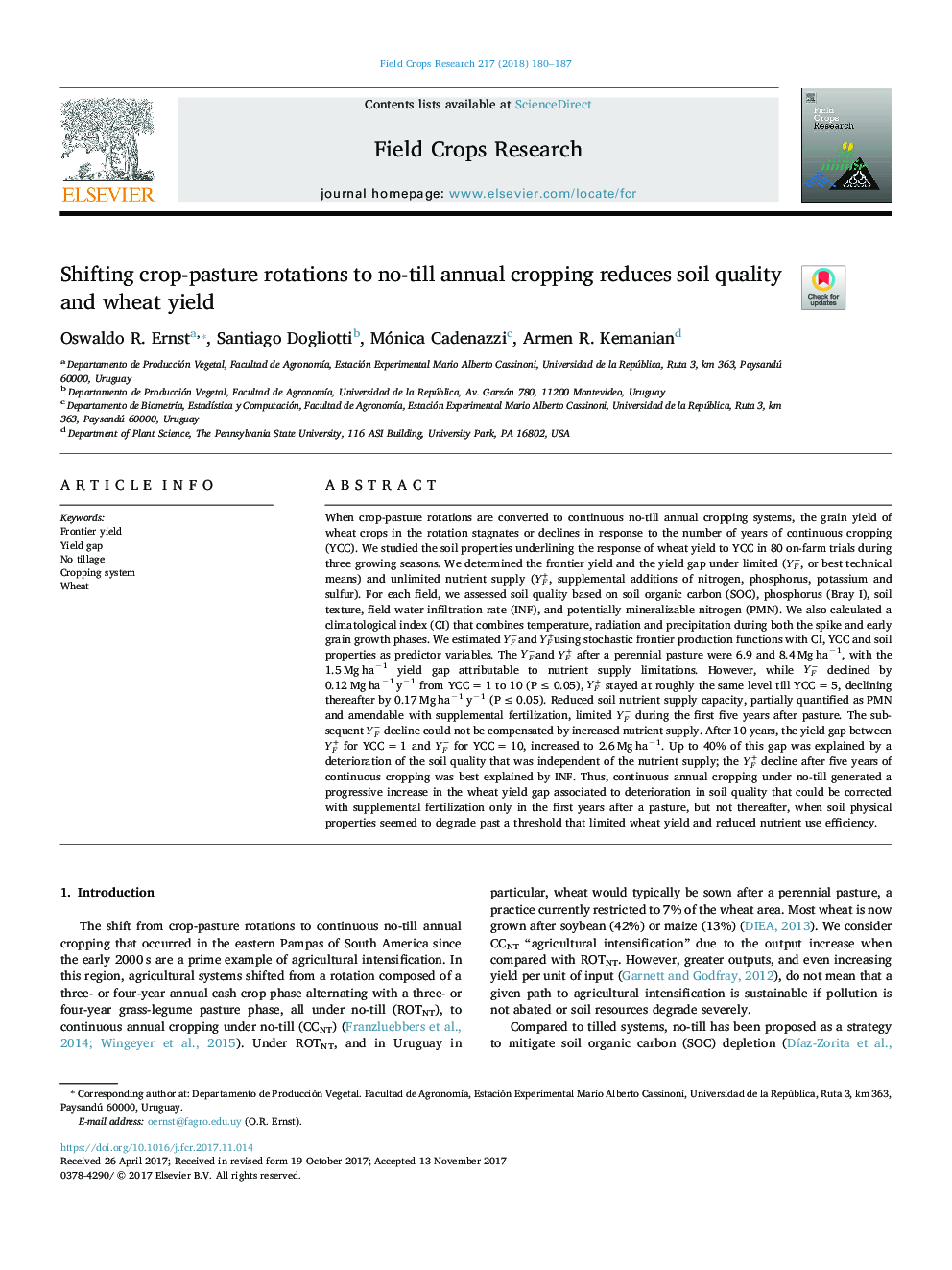| کد مقاله | کد نشریه | سال انتشار | مقاله انگلیسی | نسخه تمام متن |
|---|---|---|---|---|
| 8879406 | 1624646 | 2018 | 8 صفحه PDF | دانلود رایگان |
عنوان انگلیسی مقاله ISI
Shifting crop-pasture rotations to no-till annual cropping reduces soil quality and wheat yield
ترجمه فارسی عنوان
تغییرات کاشت محصول و کاشت به تولید سالیانه بدون محصول باعث کاهش کیفیت خاک و عملکرد گندم می
دانلود مقاله + سفارش ترجمه
دانلود مقاله ISI انگلیسی
رایگان برای ایرانیان
کلمات کلیدی
عملکرد مرزی، شکاف تولید، بدون خاکستر، سیستم برداشت، گندم،
موضوعات مرتبط
علوم زیستی و بیوفناوری
علوم کشاورزی و بیولوژیک
علوم زراعت و اصلاح نباتات
چکیده انگلیسی
When crop-pasture rotations are converted to continuous no-till annual cropping systems, the grain yield of wheat crops in the rotation stagnates or declines in response to the number of years of continuous cropping (YCC). We studied the soil properties underlining the response of wheat yield to YCC in 80 on-farm trials during three growing seasons. We determined the frontier yield and the yield gap under limited (YFâ, or best technical means) and unlimited nutrient supply (YF+, supplemental additions of nitrogen, phosphorus, potassium and sulfur). For each field, we assessed soil quality based on soil organic carbon (SOC), phosphorus (Bray I), soil texture, field water infiltration rate (INF), and potentially mineralizable nitrogen (PMN). We also calculated a climatological index (CI) that combines temperature, radiation and precipitation during both the spike and early grain growth phases. We estimated YFâand YF+using stochastic frontier production functions with CI, YCC and soil properties as predictor variables. The YFâand YF+ after a perennial pasture were 6.9 and 8.4â¯Mgâ¯haâ1, with the 1.5â¯Mgâ¯haâ1 yield gap attributable to nutrient supply limitations. However, while YFâ declined by 0.12â¯Mgâ¯haâ1â¯yâ1 from YCCâ¯=â¯1 to 10 (Pâ¯â¤â¯0.05), YF+ stayed at roughly the same level till YCCâ¯=â¯5, declining thereafter by 0.17â¯Mgâ¯haâ1â¯yâ1 (Pâ¯â¤â¯0.05). Reduced soil nutrient supply capacity, partially quantified as PMN and amendable with supplemental fertilization, limited YFâ during the first five years after pasture. The subsequent YFâ decline could not be compensated by increased nutrient supply. After 10 years, the yield gap between YF+ for YCCâ¯=â¯1 and YFâ for YCCâ¯=â¯10, increased to 2.6â¯Mgâ¯haâ1. Up to 40% of this gap was explained by a deterioration of the soil quality that was independent of the nutrient supply; the YF+ decline after five years of continuous cropping was best explained by INF. Thus, continuous annual cropping under no-till generated a progressive increase in the wheat yield gap associated to deterioration in soil quality that could be corrected with supplemental fertilization only in the first years after a pasture, but not thereafter, when soil physical properties seemed to degrade past a threshold that limited wheat yield and reduced nutrient use efficiency.
ناشر
Database: Elsevier - ScienceDirect (ساینس دایرکت)
Journal: Field Crops Research - Volume 217, March 2018, Pages 180-187
Journal: Field Crops Research - Volume 217, March 2018, Pages 180-187
نویسندگان
Oswaldo R. Ernst, Santiago Dogliotti, Mónica Cadenazzi, Armen R. Kemanian,
